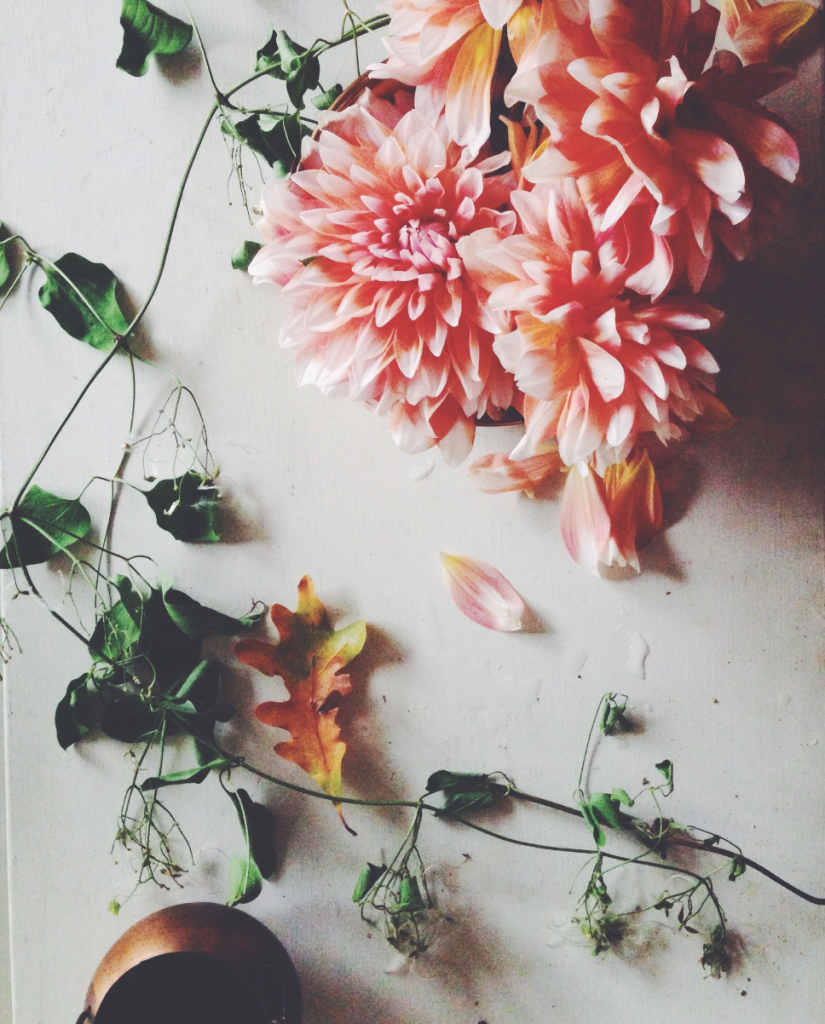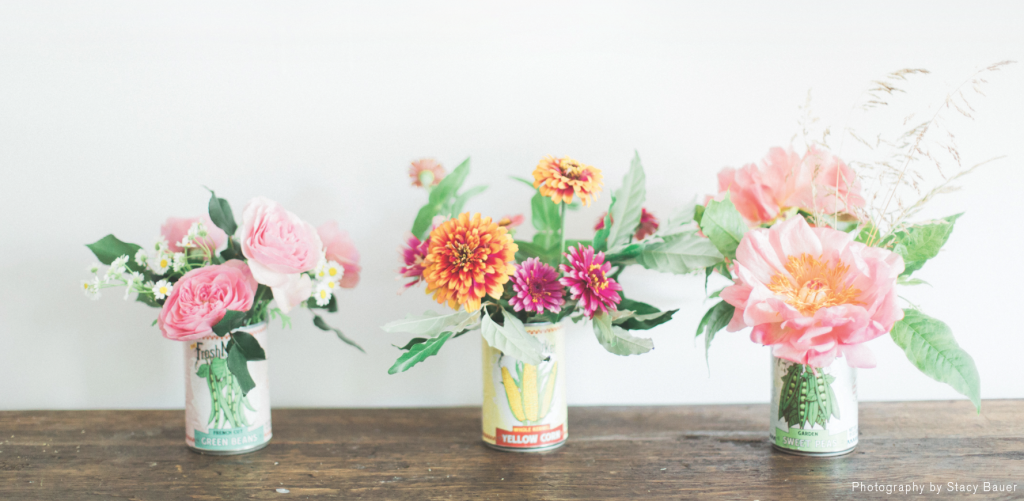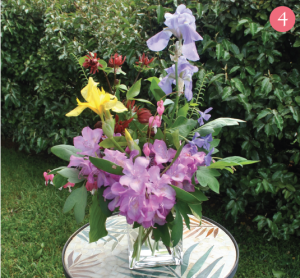Bringing Your Flower Arrangements To Life
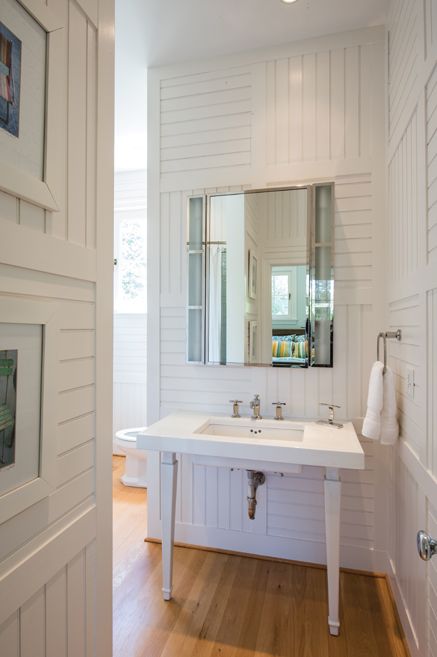
One of the most common floral mistakes: You hold an entire bunch of flowers in your hand, you trim the stems, you drop them in a vase. Lo and behold, you’re left with
a sad arrangement that lacks movement and vitality.
Here, learn how to harness the personality of your flowers and create a celebration-worthy arrangement with three different elements: “face flowers,” “filler flowers,” and greenery.
Choosing Your Flowers
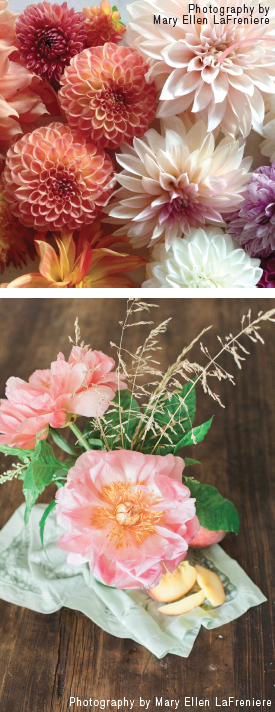 Try to source flowers from local farms or farmers markets as much as possible to enjoy the bounty that Central Virginia offers from now through October. When you look at flowers in the market, think of them as people you’re inviting to a dinner party. For a party, you usually take personalities into account to ensure that guests connect and enjoy themselves, right?
Try to source flowers from local farms or farmers markets as much as possible to enjoy the bounty that Central Virginia offers from now through October. When you look at flowers in the market, think of them as people you’re inviting to a dinner party. For a party, you usually take personalities into account to ensure that guests connect and enjoy themselves, right?
“Face flowers” are large, showy blooms—peonies, sunflowers, dahlias and the like. They become the focal point of an arrangement. They’re the party girls, the extroverts, the ones more likely to introduce themselves in a crowd.
Once you’ve chosen your party girl, grab a supporting player who is different in form and texture (these are known as “filler flowers” and add movement to the arrangement). Think of the person at the party who’s not the loudest in the room, but is delightful for one-on-one conversation: feathery celosias, foxtail grasses, Gomphrena (globe amaranth), or Queen Anne’s lace.
Insider tip: Opt for flowers in one color palette for a more refined arrangement. Pair purple dahlias with lavender Gomphrena, red zinnias with a rust celosia, or a sunflower with a lime green grass.
You might find foliage at the market as well, but you can probably source that from your own home. Some common Virginia shrubs that provide interesting foliage and texture are azaleas, ninebark, privet, honeysuckle, forsythia, and abelia. Take a walk around your yard or patio and clip bits of foliage that speak to you—you’ll probably be surprised by their long vase life.
A Flower-Arranging Tutorial
Select a vase. Cubes can be tricky—so if you’re a beginner, choose a vase with a rounded bottom. The easiest vases to design in are hourglass shape, meaning they have a wide bottom that tapers in toward the neck before flaring out again at the top. You want the narrowest point of the vase to be similar in size to the diameter of your flower stems when held in your hand, (no ruler needed; you can estimate here). Unless you’re using extra-tall blooms such as sunflowers, your vase should be no taller than 12 inches, but 6-8 inches is ideal for most locally grown flowers such as zinnias and dahlias. Stay away from floral foam for home arrangements; with well-placed greenery, you don’t need it. (Floral foam is not eco-friendly and those little foam particles could be inhaled—eeek!)
Now to arrange:
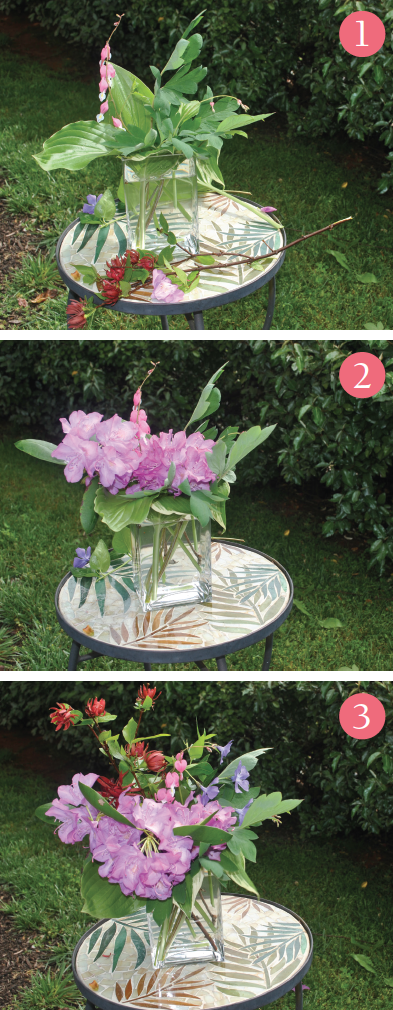 Create a greenery foundation: The goal here is to build a base to support your stems, so cut a few pieces the approximate height of your vessel, and place them resting right on the lip of the container. You may need to angle these stems slightly so that the weight of the greenery is supported by the lip. If the greenery allows, let some of the foliage cascade over the edge of the vase to add interest, to craft a more seamless look. Usually it takes 2 to 4 pieces of greenery to create a secure foundation, depending on the vase size and the type of green.
Create a greenery foundation: The goal here is to build a base to support your stems, so cut a few pieces the approximate height of your vessel, and place them resting right on the lip of the container. You may need to angle these stems slightly so that the weight of the greenery is supported by the lip. If the greenery allows, let some of the foliage cascade over the edge of the vase to add interest, to craft a more seamless look. Usually it takes 2 to 4 pieces of greenery to create a secure foundation, depending on the vase size and the type of green.- Now it’s time to place your flowers: Lay your flowers on the counter and strip each stem of greenery that would sit below water level in the vase, but make sure to leave some foliage around the top portion of the stem. Now, cut each stem individually, just before you place it in the vase. Arrange 1 to 3 blooms low in the vessel, resting on top of your greenery to secure it in place, and to add depth. As you begin to place more “face flowers,” experiment with different heights, considering the final shape you want. Rather than trying to align the flowers evenly, revisit the party idea and place them in groupings. (A few gals talking on the left side of the room, two people in center, one person in the kitchen by him or herself, know what I mean?) Allow natural spacing to occur. Save two of your “face flowers” to place at the very end.
- Now, to add movement with your “filler flowers” (this is where things get good): Take a step back from your arrangement for a moment, and pay attention to the overall form. Which direction is the arrangement moving? Where does it need to move? Think of house guests in fluid motion—turning toward each other, turning away. Incorporate clustering again—two shooting off to the left-hand side, a few dripping down the bottom right. Let your imagination run wild. You’ll probably find arranging this way surprisingly difficult at first, to not space everything evenly, but after a few tries it will become second nature. When you’re happy with the “movement” you’ve created, use any remaining filler to plug holes. Conceal the lip of the vase.
- Final step: add your last two “face flowers.” This is where dimension happens. By now, you have at least three layers composed of greenery, focal flowers and filler flowers. Lush it up by inserting the final flowers in front of the others, as if they’re reaching out to say helloooo. This extra layer makes the arrangement look simultaneously effortless and luxurious.
Now you’re ready. Make your flowers the life of the party!
Mary Ellen LaFreniere got her start on Irvington Spring Farm, her parents’ 3-acre cut-flower farm in Lynchburg. She has since transplanted to Baltimore where she creates “a marriage of grit and grace” through her urban micro-farm and floral design company. You can find her on instagram @steelctuflowerco or on the web at www.steelcutflowerco.com.
A Passion For flowers, arrangements, dahlias, diy, face flowers, filler flowers, flower experts, flower-arranging, flowers, greenery, peonies, queen anne's lace, sunflowers
